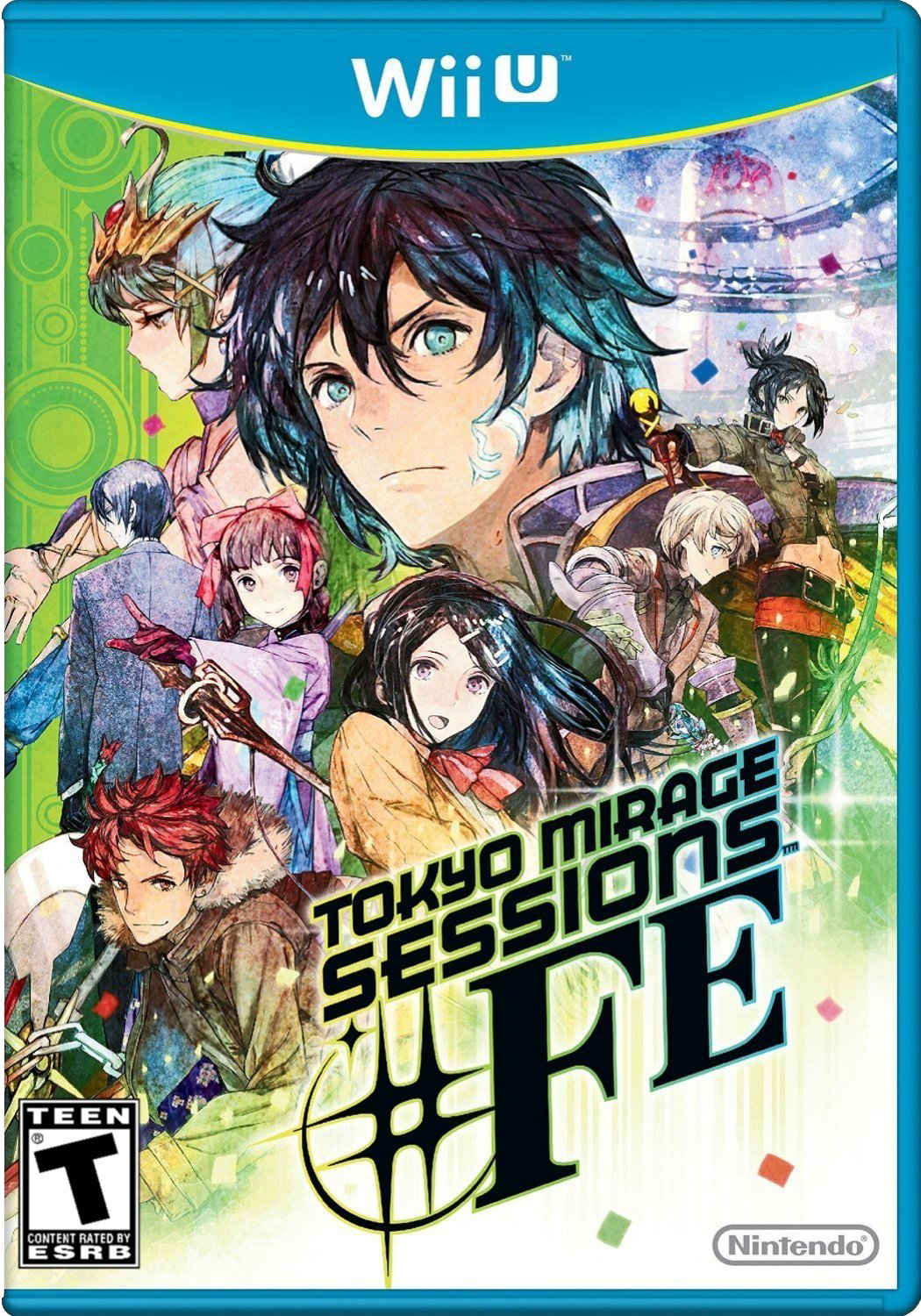When this crossover was announced not a lot of people knew what to expect from Shin Megami Tensei x Fire Emblem. These were two games with some amount of common ground but vastly different approaches to their gameplay and story tones. It was an exciting prospect, as I’ve had plenty of exposure to both of these storied franchises and could at least come up with possibilities. Fast forward a bit to the reveal trailer of Tokyo Mirage Sessions ♯FE, and like pretty much everyone else, I was caught off guard by what I saw. That said, I was cautiously optimistic of what would come, and I’m happy to say that that attitude has paid off. This isn’t about what could have been or what was changed at any given point; it’s about setting the stage for the game I’ve now played and how it brings these two worlds together while also crafting its own, distinct image.
Setting the stage for your debut
For anyone coming in blind, Tokyo Mirage Sessions ♯FE is not so much a crossover as it is a thematic merger of Nintendo’s own Fire Emblem and Atlus’ Shin Megami Tensei. Certain characters and abilities share their names with material from both games, a few familiar musical cues and chimes find their way in, and the importance of your party is at the forefront. That said, gone are the medieval beats of Fire Emblem and the often times apocalyptic tones of MegaTen, and instead stands a bright and vibrant, modern Tokyo and a look at its entertainment industry. Idol culture is at the heart of the entire experience, both for the characters’ story and your experience as a player. I wasn’t asked to start a new game, I was asked to “Debut.” Status pages take the form of detailed profiles with glamour shots and a “likes/dislikes” section. One of my favorites is that when casting spells characters actually use their autographs as a means to channel it, writing them in the air before firing off an attack. It’s these subtle, interface related elements that really sold the game for me. And while the plot’s premise is a unique twist for an RPG, I just couldn’t get invested in it.

Playing as Itsuki Aoi, a young everyman type of character, you follow a thread of events that leads to your rescuing of childhood friend and aspiring Idol Tsubasa Oribe – awakening both of your latent powers at the same time. This all takes place in hidden spaces within Tokyo called Idolaspheres, where Mirages dwell in pursuit of Performa. As ridiculous as these terms can seem, they work within the game itself and play their part in crafting its own identity. Idolaspheres are the game’s dungeon environments for you to explore and fight enemies within, each themed after aspects of the culture such as one centered on photography and camera motifs. Mirages are the enemies within, resembling shadows from Shin Megami Tensei offshoot Persona in their behaviors and designs but at times themed after Fire Emblem classes. Performa is the “latent power” I spoke of, representing characters’ power to reach out to others via ‘performing’ that the Mirages seek to claim for themselves. Once broken down, it’s all pretty standard fare, but I can appreciate its attempts at world building.

Outside of the Idolasphere dungeons and attempting to figure out just what their purpose and the Mirages’ goals are, the plot concerns a group of entertainers and mentors working for the Fortuna talent agency. Shortly after the game’s prologue, Itsuki and Tsubasa are both brought in to this group, where you slowly meet the rest of your party members. While the localized script itself is fine overall, the plot itself simply didn’t draw me in. Part of this I attribute to Itsuki and Tsubasa themselves, who struck me as ultimately a little boring when contrasted by the rest of the cast. Itsuki being so devoid of personality I could forgive, as he also has to serve as your avatar through the proceedings, but Tsubasa’s overall blandness is unfortunate and not as easily excusable. Thankfully, the rest of the main characters were enjoyable and more unique in their motivations and personalities, keeping me invested as I learned more about them.
Making the action count Session after Session
Like many RPGs, it takes some time to find its pace but as a whole, I never found myself wanting to “stop” playing, nor did I ever play “just because.” Much of that I attribute to the game’s excellent battle system, which stands as the highlight of the entire game. Mirages aren’t all evil you see, and each of your party members has a Mirage standing at their sides that allows them to fight within the Idolasphere. They are the clearest parallel to the Persona series, though unlike a Persona, they’re all characters in their own right. Each of these allied Mirages also represents a Fire Emblem character, such as Itsuki fighting alongside Chrom from Fire Emblem Awakening. Every Mirage has a form of amnesia that makes their relation to the “true” Chrom, for example, a bit unclear, but regardless, their bond with your characters and their Performa allows them to combine their powers via what the game calls Carnage Form. Every battle puts you in Carnage Form and allows you to utilize skills from the Shin Megami Tensei series, such as Zio or Dia, basic lightning and healing spells respectively. As you level up your Carnages you’ll gain more skills to use, though there’s a finite amount that each Mirage can have at a given time, placing some importance on deciding what should be kept and what can be forgotten.

Enemies have many potential weaknesses that can be divided into three distinct varieties. The first takes the form of Fire Emblem’s own weapon triangle, where swords beat axes beat lances beat swords. The next is elemental weaknesses exploitable by the MegaTen-esque spells or physical attacks imbued with fire or ice. And finally, there are more situational weaknesses, such as flying enemies being susceptible to bows or skills that specifically shred through horse riding enemies. Exploiting these weaknesses is of the utmost importance, as anytime an enemy is attacked by at least one of its weaknesses, a Session can begin. With the proper skills learned from gaining new Carnages and developing them, your party members can follow up the weakness-exploiting attack with an attack of their own that’ll ignore enemy resistances. These can then be followed by further attacks from other party members, making for lengthy chains of attacks that complement each other. Taking advantage of Sessions leads to a much higher damage output and greater monetary and item bonuses, meaning there’s really no reason not to utilize them when available, as their only limitation is in the form of an easily replenished energy bar.
Figuring out optimal Sessions and watching my cast actively support each other in this way was really entertaining and encouraging. Be warned, however, that enemy Mirages can also initiate Sessions, leading to greater damage to your own party members. Relying on Sessions is both the safest and most enjoyable way to battle, and without them (such as when a party member is stunned) the fights can become much more difficult and overwhelming. Thankfully, having played MegaTen games before, I knew better than to neglect buff and debuff spells. Boss fights in particular could get rough if you’re unable to learn enemy patterns and abilities on the fly in order to best plan rounds, keeping the tension up. I enjoy the difficulty the game offers, though if you’re the type of player that avoids standard battles often, be warned that’s ill advised here. I haven’t hit a wall where I’ve needed to grind, personally, but I fight almost everything I see and constantly switch out my Carnages to gain new skills.

Catching your breath in the intermission
This flow of gaining new Carnages, unlocking their skills through battle, using the dropped materials to forge other new Carnages (as well as unlock passive abilities and more specific skills), then heading back into the Idolasphere to keep fighting forward forms the Tokyo Mirage’s progression. My biggest problem with the game is that I have to leave the Idolasphere to return to a separate location to get these new Carnages and other skills. Called the Bloom Palace, a friendly Mirage representing recurring Fire Emblem character Tiki would grant these to me once I had the requisite materials. While I unlocked a skill to warp to the Bloom Palace fairly early, it still added a recurring amount of tedium to make my way back to the Idolasphere after every trip, even with fast travel. While I could have held off to do these in one go later, once you have all the skills from a given Carnage, it doesn’t serve any purpose to use it if there’s a stronger one with more skills that grant more Session opportunities available. If it happened occasionally, it would be a minor gripe but I found myself taking several trips in and out per dungeon.
The overworld between Idolaspheres was a bit lacking, though I do enjoy the bright colors used to represent NPCs going about their way in an attempt to mimic the crowded nature of Shibuya. There’s no incentive to explore it, which is a shame because the modern setting is something the game leans on to set itself apart. Sometimes NPCs will have missions for you, but these were more distractions than satisfying finds. Conversely, I found the GamePad’s use as a communication tool with your party very enjoyable. Various alerts will prompt you to tap through a social media app called Topic, a clear Line analogue where your party members will message you with both story-relevant info and occasional glimpses into their personalities and interests. There’s even one that prompts you when new Carnages can be formed based on your inventory, which I can appreciate as a convenience but also deride for how it served as a notification that it was time for me to do that same dance again.

Performing with the right co-stars
Outside of the battle system, my favorite part of the game involved the side quests based on your party and other Fortuna members. Unlike the NPC-rooted quests I mentioned before, these side events are much more involved and you’ll be alerted to them via the GamePad. These flesh out your party members and have greater rewards, such as extra attacks in battle or passive effects for dungeon exploration. The real reward though is building up connections to the cast of characters, as they were the real highlight of the experience. They each have a story to tell, and even if the focus on Idol culture and the entertainment industry doesn’t mesh with you, these more humanizing displays got me to care more, which is more than I can say for the overarching plot. The game’s tone as a whole is lighter than its source franchises – I found this refreshing, for it made the moments that took a darker turn more impactful as a result.
Graphically, TMS’s greatest strength is vibrancy. When it commits to the stylish approach it really pays off, and though the in-game models aren’t entirely impressive, they’re more than serviceable and make the interface pop even more. There were two other types of animation as well, those being more anime inspired sequences and ones resembling recent Fire Emblem games’ cutscenes. I felt this stood out among all the styles, though it’s usually reserved for what are effectively music videos within the game. The Idol songs are catchy in the way pop music is – however, I think it’s important to note that I’m not sold on the soundtrack of the game itself. And honestly, I is a shame, as I’d have hoped that a game focusing on the music industry would show more variety and depth with its songs. Again, it’s the green-hued interface that steals the show and serves as the game’s greatest stylistic flair. It’s the saving grace of the presentation and the best use of its Idol terminology and focus.

Final curtain call
Tokyo Mirage Sessions ♯FE is a game with a history of surprises. The reveal of the initial partnership between Nintendo and Atlus was unexpected, as was the nature of what that collaboration would become. Most pleasantly surprising is that it still manages to work, and I’ve enjoyed playing the game and seeing all it has to offer Wii U owners. While I don’t think it reaches the heights its source materials do, it’s still an enjoyable RPG with a fantastic battle system, cast of characters and interface. Sadly, the narrative doesn’t reach these heights; and with a sparse overworld and some tedium in place, it doesn’t reach its full potential. My likes outweigh my dislikes though, and with the lack of RPGs on the Wii U, I can comfortably recommend it for anyone who enjoys JRPGs. Simply put: If those aren’t for you, then neither is this game. I do hope that people will play it so they can enjoy the strengths that I’ve come to appreciate so that this cast can potentially see a better encore performance.
Leave a Comment
System: Nintendo Wii U
Release date: June 24th, 2016
Category: Role-playing game
Publisher: Nintendo
Developers: Atlus, Intelligent Systems


